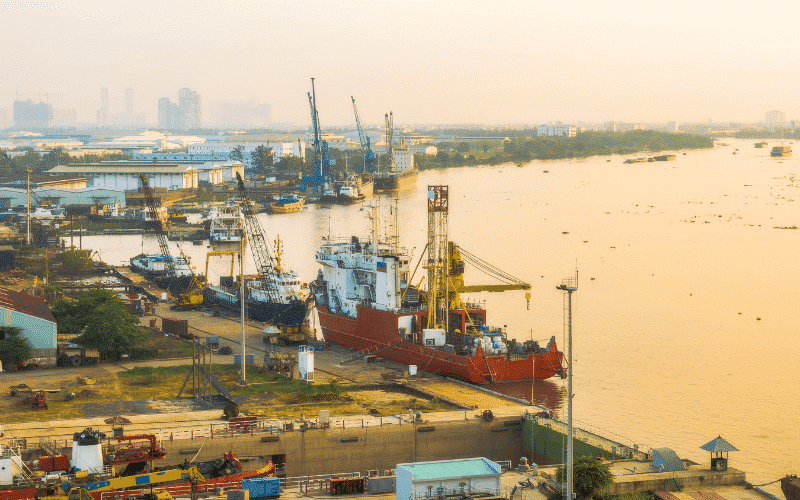Key Logistics Zones to Watch in Vietnam by 2025
Vietnam’s logistics sector is undergoing a transformative phase, positioning itself as a pivotal hub in Southeast Asia. With strategic investments, infrastructural developments, and policy reforms, several key logistics zones are emerging as focal points for growth and investment. Here’s an in-depth look at the regions poised to shape Vietnam’s logistics landscape by 2025.
1. Hai Phong: Northern Gateway to Global Trade
Hai Phong, a major port city in northern Vietnam, is rapidly evolving into a critical logistics and industrial hub. The city’s strategic location, coupled with significant infrastructural investments, has attracted substantial foreign direct investment (FDI).
-
Nam Dinh Vu Industrial Park: This zone has garnered attention with investments like the $100 million project by Brazilian meatpacker JBS, aiming to establish a logistics center and processing facilities. Reuters
-
Port Infrastructure: Hai Phong’s port system is among the largest in Vietnam, facilitating significant cargo volumes and serving as a linchpin for northern Vietnam’s manufacturing exports. Vietnam Briefing+2the-shiv+2Vietnam Briefing+2
2. Ba Ria–Vung Tau: Southern Maritime Powerhouse
Located in southern Vietnam, Ba Ria–Vung Tau province is home to the Cai Mep–Thi Vai port complex, one of the country’s most advanced deep-water ports.
-
Cai Mep–Thi Vai Port: This port complex is capable of accommodating large vessels, enhancing Vietnam’s maritime connectivity and reducing reliance on transshipment hubs.
-
Hac Dich Industrial Park: Spanning 450 hectares, this industrial park is part of the province’s broader strategy to bolster its logistics and industrial capacities. Vietnam Briefing
3. Long An: Emerging Logistics Nexus
Adjacent to Ho Chi Minh City, Long An province is capitalizing on its proximity to major urban centers to develop its logistics infrastructure.
-
Duc Hoa III – SLICO Industrial Park: Covering 200 hectares, this park is attracting investments in manufacturing and logistics, aiming to alleviate congestion in Ho Chi Minh City. Vietnam Briefing
-
Infrastructure Development: The province is investing in road and port infrastructure to enhance connectivity and support its logistics ambitions.
4. Dong Nai and Binh Duong: Industrial and Logistics Powerhouses
These provinces are integral to Vietnam’s industrial landscape, with well-established industrial zones and robust logistics networks.
-
Phuoc Binh 2 Industrial Park (Dong Nai): Encompassing 287 hectares, this park is part of the province’s strategy to attract high-tech and logistics investments. Vietnam Briefing
-
Nam Tan Uyen Industrial Park Phase 2 (Binh Duong): With an additional 345 hectares, this expansion underscores the province’s commitment to industrial growth.
Both provinces benefit from their strategic locations near Ho Chi Minh City and access to major highways and ports.
5. Da Nang: Central Vietnam’s Logistics Hub
Da Nang is positioning itself as a central logistics hub, leveraging its strategic coastal location and ongoing infrastructural projects.
-
Lien Chieu Port: This deep-water port is under development to handle increased cargo volumes and reduce pressure on existing ports.
-
Free Trade Zone Initiatives: The city is exploring the establishment of free trade zones to attract investment and enhance its logistics capabilities. Vietnam+ (VietnamPlus)
6. Bac Ninh: High-Tech and Logistics Integration
Bac Ninh province is emerging as a hub for high-tech industries and logistics, driven by significant FDI and infrastructural investments.
-
Industrial Zones: The province hosts several industrial parks that cater to electronics and high-tech manufacturing, necessitating advanced logistics solutions.
-
Connectivity: Proximity to Hanoi and access to major highways and ports bolster Bac Ninh’s logistics appeal.
Government Initiatives and Policy Support
Vietnam’s government is actively supporting the development of its logistics sector through various initiatives:
-
Logistics Development Plan: Aiming to reduce logistics costs from 18% to 15% of GDP by 2025, the plan focuses on enhancing infrastructure, streamlining customs procedures, and adopting digital technologies. Vietnam+ (VietnamPlus)+1vietnamlawmagazine.vn+1
-
Free Trade Zones: The establishment of free trade zones is seen as a strategic move to boost trade, attract investment, and position Vietnam as a regional logistics hub. Vietnam+ (VietnamPlus)
Conclusion
As Vietnam continues its economic ascent, the development of key logistics zones is critical to sustaining growth and enhancing global competitiveness. Regions like Hai Phong, Ba Ria–Vung Tau, Long An, Dong Nai, Binh Duong, Da Nang, and Bac Ninh are at the forefront of this transformation, offering promising opportunities for investors and stakeholders in the logistics sector.InCorp Vietnam+1Vietnam Briefing+1
